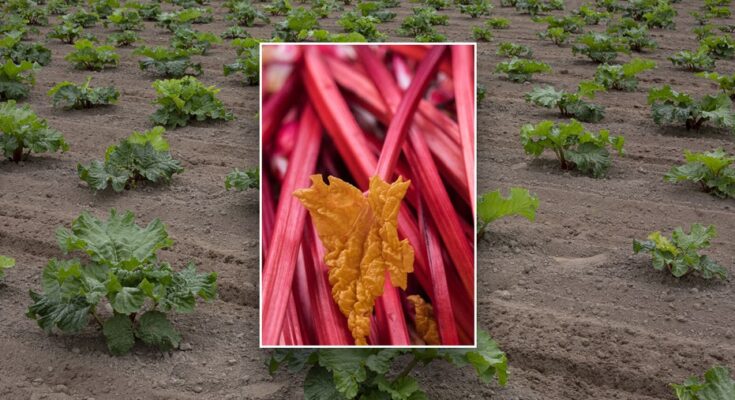Rhubarb is a vegetable that visually appears to resemble celery in texture — but its color and taste are differentiating factors between the two.
Rhubarb has an extremely tart flavor, and it is very rarely eaten on its own due to its sour notes. It’s often combined with sugar in sweet treats like pie or jam.
Even though rhubarb is often used in desserts, it’s actually full of health benefits.
SKIN, HAIR BENEFITS OF JOJOBA OIL, WIDELY USED IN COSMETICS, ACCORDING TO EXPERT
While combining rhubarb with sugar may not be the healthiest approach to take, there are plenty of other healthy ways to counteract rhubarb’s sour flavor.
Find out more about the health benefits of rhubarb and how you can easily incorporate it into your diet below.
There are many different vitamins present in rhubarb.
One of these is vitamin K, an important contributor to overall bone health as well as blood clotting.
POTENTIAL HEALTH BENEFITS OF TARRAGON, INCLUDING IMPROVED DIGESTION, ACCORDING TO EXPERT
“Just one cup of rhubarb has almost half of your vitamin K needs,” Lauri Wright, associate professor of nutrition and dietetics at the University of South Florida and registered dietitian nutritionist, told Fox News Digital.
Wright added that though most people don’t take Coumadin anymore for blood thinning, those who are on medication should be extra cautious of rhubarb consumption since vitamin K and Coumadin don’t interact well.
Calcium is also apparent in rhubarb, another contributor to bone health, as well as vitamin C, great for a nice immune boost.
“It’s also rich in calcium, which helps with bone health, and vitamin C, which boosts your immunity and is involved in collagen production for healthy skin and tissues,” Wright said.
Rhubarb is full of antioxidants.
THE HEALTH BENEFITS OF MATCHA, PACKED WITH ANTIOXIDANTS, MAY BE WORTH INCORPORATING INTO YOUR DIET
The antioxidants in rhubarb do far more than just give the vegetable its color.
“Rhubarb is really high in antioxidants, and those are kind of these compounds that give the rhubarb its reddish color, but those compounds in the body help take down inflammation and protect the cells from damage… some of the damage that could eventually lead to cancer cells,” Wright explained.
Rhubarb is a vegetable high in fiber.
“[Rhubarb is] rich in fiber, so it really helps with digestion. [It] has a pretty good source of fiber per serving,” Wright told Fox News Digital.
CLICK HERE TO SIGN UP FOR OUR HEALTH NEWSLETTER
That said, the amount of fiber in rhubarb shouldn’t lead to any GI issues, Wright added.
The part of the vegetable to be mindful of is the leaves. While rhubarb stalks boast impressive health benefits, the leaves should be left alone.
“The leaves actually contain oxalic acid, which, if you eat a lot of it, can be toxic, and it also, for some people, can build stones in the kidneys. So you always want to trim the leaves before you cook the rhubarb,” Wright noted.
Rhubarb has the potential to regulate blood pressure.
The high potassium content in the vegetable is what strongly contributes to this potential health benefit, Wright told Fox News Digital.
For more Health articles, visit www.foxnews.com/health
“It’s high in potassium,” Wright said. “Potassium helps regulate blood pressure [and] helps with better blood pressure control.”
Rhubarb stalks may have the capability to lower bad cholesterol levels.
“Studies have actually shown that rhubarb stalks can help lower the LDL cholesterol, or the bad cholesterol … just a few, but there’s some promise there,” Wright said.
If you want to begin to incorporate rhubarb into your diet in a healthy way to see all of its potential benefits, one easy way to do so is by using it as an ingredient in salsa.
“One really fun idea is [to] add rhubarb to your salsa,” Wright said. “Dice up rhubarb along with mango, red onion, lime juice, cilantro. That makes a really tangy salsa, and it’s perfect to put on top of grilled fish or chicken.”
Another easy way to incorporate pretty much any fruit or vegetable into a diet is by blending it into a smoothie.
“Add rhubarb to your smoothie with strawberries, Greek yogurt, a little drizzle of honey and maybe some spinach, and that’s going to be like a really fun mix of flavors that is packed with nutrition,” Wright explained.
A nutrient-rich smoothie is a super simple way for those who have a hard time meeting daily recommended intakes of fruits and vegetables to get the vitamins and minerals they need.



